Antique radio
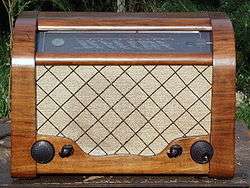
An antique radio is a radio receiving set that is collectible because of its age and rarity. Although there is no precise criterion for a radio being antique, typically a 50-year-old or World War II vacuum tube set, and a pre-1960 transistor set.
Types of antique radio
Morse receivers
The first radio receivers used a coherer and sounding board, and were only able to receive CW continuous wave (CW) transmissions, encoded with Morse code (wireless telegraphy). Later wireless telephony|transmission and reception of speech became possible, although Morse code transmission continued in use until the 1990s.
All the following sections concern speech-capable radio, or wireless telephony.
Early home-made sets
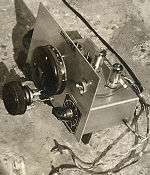
The idea of radio as entertainment took off in 1920, with the opening of the first stations established specifically for broadcast to the public such as KDKA in Pittsburgh and WWJ in Detroit. More stations opened in cities across North America in the following years and radio ownership steadily gained in popularity. Radio sets from before 1920 are rarities, and are probably military artifacts. Sets made prior to approximately 1924 were usually made on wooden breadboards, in small cupboard style cabinets, or sometimes on an open sheet metal chassis. Homemade sets remained a strong sector of radio production until the early 1930s. Until then there were more homemade sets in use than commercial sets.
Early sets used any of the following technologies:
- Crystal set
- Crystal set with carbon or mechanical amplifier
- Basic Tuned Radio Frequency (TRF) Sets
- Reaction Sets
- Super-Regenerative Receiver
- Superheterodyne Receiver
Crystal sets
These basic radios used no battery, had no amplification and could only operate high-impedance headphones. They would only receive very strong signals from a local station. They were popular among the less wealthy due to their low build cost and zero run cost. Crystal sets had minimal ability to separate stations, and where more than one high power station was present, inability to receive one without the other was a common problem.
Some crystal set users added a carbon amplifier or a mechanical turntable amplifier to give enough output to operate a speaker. Some even used a flame amplifier.
Tuned radio frequency sets
Tuned Radio Frequency sets (TRF sets) were the most popular class of early radio, primarily because the RCA company had a lock on the superheterodyne circuit patents and it was more profitable for companies to jump into radio manufacturing TRF sets. These used several valves (tubes) to provide RF amplification, detection, and audio amplification. Early TRF sets only operated headphones, but by the mid-1920s it was more common to use additional amplification to power a loudspeaker, despite the expense. The sound quality produced from "moving-iron" speakers used on such sets is sometimes described as torturous, although by the late 1920s the Kellogg-Rice dynamic (moving-coil) speaker had begun to find favor due to its superior sound-reproduction ability.
Speakers widely used on TRF sets included:
- Moving iron speaker (horn or cone)
- tin can, magnet & wire based speakers
- moving coil speaker
TRF sets used no regeneration, and were merely several stages (typically three) of tuned RF amplifiers in series feeding a detector tube which extracted the audio intelligence from the RF signal. TRF sets, depending on the number of stages they employed, could have poor-to-superb sensitivity (ability of the set to pick up faint signals) and corresponding selectivity (ability to parse adjacent stations from one another). Audio reproduction quality of TRF sets was limited by the available loudspeakers. "High Fidelity" was not to become a radio marketing concept until the mid-1930s and was not realized until the advent of FM broadcasting.
Reaction sets, also known as regenerative receivers, rely on positive feedback to achieve adequate gain. This approach provided high performance with a minimum number of expensive vacuum tubes, but these receivers tended to radiate RF interference in their immediate vicinity. Consequently, there was a significant amount of hostility by neighbors of "regen" set users over maladjusted radios transmitting squealing noises and blocking reception on nearby properties.
Early TRF sets had typically two or three tuning knobs and tube filament voltage-control rheostats, all of which had to be set correctly to receive a station. Later (late 1920s) TRF sets had ganged tuning (one knob was used to control all stage tuning capacitors simultaneously), AC house current operation, and eliminated the filament voltage adjustments. All of these changes greatly simplified operation and made radio a household appliance that even a small child could operate, instead of the highly skilled hobbyists of the brief preceding generation. Reaction sets also had the filament adjustment rheostats for each valve, and again settings had to be right to achieve reception.
Superheterodyne receivers
In the era of early radio, only RCA and a select number of competing "prestige" radio manufacturers could afford to build a superheterodyne receiver (superhet). The RCA Corporation had exclusive rights to the superheterodyne circuit patents and extracted high licensing fees from other companies who sought to build superhet sets. RCA also vigorously prosecuted patent infringers. This situation tended to propel RCA into the forefront of radio manufacturers in the 1920s due to the higher efficiency of the superhet circuit- a situation which lasted until the patents expired in the early 1930s, at which time a flood of low-cost superheterodyne receivers hit the marketplace. Early (RCA-patent-era) superhets were often used with the relatively expensive moving coil speakers, which offer a quality of sound unavailable from moving iron speakers.
Most post-1932 commercial radios were superhets, and this technology is still in widespread use in radio receivers today, implemented with transistors or integrated circuits.
The advantages of superhets are:
- Excellent sensitivity and selectivity
- Ease of designing the set for multiple-band operation, enabling reception of foreign broadcasts ("Shortwave")
- High stability
- Well controlled bandwidth
- Well shaped RF passband avoids the uncontrolled tone variations of TRF sets, and gives good selectivity
The disadvantages before about 1932 were:
- High patent-licensing costs.
- Need for specialized test equipment to perform conversion-stage filter alignments.
In general the technical and manufacturing advantages of the superhet ensured that the TRF set became quickly obsolete once the patent restrictions on superhets were eliminated.
Farm radios
Prior to the Rural Electrification Act of 1936, the vast majority of farms in America did not have electricity. Some did not receive commercial power until the 1960s. Until that point, special radios were made to run on DC power. The earliest farm radios used the "A", "B", and "C" batteries typical of 1920s radio sets; these "farm radios" were identical to those used in cities. Somewhat later, farm sets were made to be run on 6 volts from a car or tractor battery, using an electromechanical vibrator to create a pulsating DC current that could be stepped up though a transformer to create the high voltage needed for the plates of the tubes- exactly as contemporary automobile radios did. Other farm radios were designed to run on 32 volts DC, from a bank of lead-acid storage batteries charged from a gas generator or a wind-charger. The 32-volt system could also power other specially made appliances as well as electric lights around the farm. Other farm radios, especially from the late 1930s to the 1950s, reverted to using a large "A-B" dry cell that provided both 90 volts for the tube plates and 1.5 volts for the tube filaments, as did most tube-based portable radios of the era.
Foxhole radios
World War 2 created widespread urgent need for radio communication, and foxhole sets were built by people without access to traditional radio parts. A foxhole radio is a simple crystal sets radio receiver cobbled together from whatever parts one could make (which were very few indeed) or scrounge from junked equipment. Such a set typically used lighting flex for an aerial, a double-edged safety-razor blade and pencil-lead (or bent safety-pin) for a detector, and a tin can, magnet and some wire for an earpiece. Razor blades of the era were chemically coated ("blued") and this coating could function as a rectifier, in the same way that a galena-catwhisker detector operates.
Wooden consoles
The console radio was the center piece of household entertainment in the era of radio. They were big and expensive costing hundreds of dollars (then-year dollars) in the late 1930s. Tending to be a major-expense acquisition for a middle-class family, these radios were usually placed in living rooms, much as televisions were to be located in a later age.Most early console radios were tall and narrow, but as the years went on they got shorter and wider in accordance with the Art Deco design precepts which had gained trendiness. Consumer console radios were made by RCA, Philco, General Electric, Montgomery Ward (under the Airline brand name), Sears (under the Silvertone brand name), Westinghouse, Motorola, Zenith and scores more. Brands such as Zenith made a few models ("Stratosphere") which catered to the extremely wealthy but mainly produced competitively priced radios affordable by anyone with a good income. Some premium makers such as E. H. Scott and Silver-Marshall were affordable only by the very rich as their prices ran into the $500–$800 range (and up) in the 1930s and 1940s, which on the high end was more than the cost of a luxury automobile.
Table-top wood-cased radios
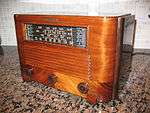
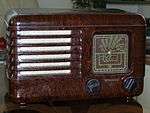
Table top radios came in many forms:
- "Cathedral style", an upright rectangular box with a rounded top
- "Tombstone style" were rectangular boxes that were tall and narrow like a tombstone
- "Table top" were rectangular, with width being the larger dimension. Table top radios were usually placed in the kitchen, sitting room or bedroom, and sometimes used out on the porch.
Bakelite
The availability of the first mass-produced plastic Bakelite allowed designers much more creativity in cabinet styling, and significantly reduced costs. However, Bakelite is a brittle plastic, and dropping a radio could easily break the case. Bakelite is a brown-black mouldable thermosetting plastic, and is still used in some products today.
In the 1930s some radios were manufactured using Catalin, which is the phenolic resin component of bakelite, with no organic filler added, but nearly all historic bakelite radios are the standard black-brown bakelite color. Bakelite as used for radio cabinets was traditionally brown, and this color came from the ground walnut shell flour added to the thermosetting phenolic resin as an extender and strengthening agent.
Plastic era

The affordability of more modern light coloured thermoplastics in the 1950s made brighter designs practical. Some of these thermoplastics are slightly translucent.
Early transistor radios
The invention of the transistor made it possible to produce small portable radios that did not need a warm-up time, and ran on much smaller batteries. They were convenient, though the prices were high and the sound quality not so good.
Transistor radios were available in many sizes from console to table-top to matchbox. Transistors are still used in today's radios, though the integrated circuit containing a large number of transistors has surpassed the use of singly packed transistors for the majority of radio circuitry.
Transistor radios appeared on the market in 1954, but at a high price. By the 1960s, reduced prices and the desire for portability made them very popular.
There was something of a marketing war over the number of transistors sets contained, with many models named after this number. Some sets even had non-functional reject transistors soldered to the circuit board, doing absolutely nothing, so the sales pitch could advertise a higher number of transistors.
Vacuum tube radios and early transistor radios were hand assembled. Today radios are designed with the assistance of computers and manufactured with much greater use of machinery.
Today's radios are usually uneconomic to repair because mass production and technological improvements in numerous areas have made them so cheap to buy, while the cost of human labour and workshop overheads have not fallen in real terms.
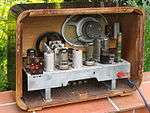
Car radios
The earliest car radios appeared not long after commercial radio broadcasts commenced, but were experimental only. They were expensive, required a large aerial, reception was inconsistent, and they required adjustment in use, which was not very practical.
By the early 1930s most car radios, no longer experimental, were superheterodynes and used a vibrator power supply to step up the low voltage to high voltage ("B+" voltage of anywhere from 90 to 250 volts) for the vacuum tubes. Vibrators are relatively unreliable as electromechanical components of limited life, buzz audibly, and produce radio interference. A few radios used a bulkier and more expensive motor-generator or motor-alternator set called a "dynamotor" that spun a high-voltage generator or alternator using a 6 or 12V DC motor. Filaments were powered using 6V and later 12V DC power from the vehicle's electrical system directly.
With the introduction of transistors, the earlier ones suitable for audio frequencies only, car radios were valve sets with a transistor output stage; makers promoted them as transistor sets. Some historic car radios badged as transistorised are in reality of this type. All-transistor sets eventually replaced sets with vacuum tube after transistor technology improved and prices fell significantly.
Chrysler and Philco announced an all-transistor car radio in the April 28, 1955 edition of the Wall Street Journal.[1] This Philco car radio model was the first tubeless auto set in history to be developed and produced.[2] It was a $150 option for 1956 Chrysler and Imperial cars and hit the showroom floor on October 21, 1955.[3][4][5]
Warm-up time
Most valve sets needed a few seconds for the valves to heat up, though there were exceptions. Warm-up times changed as valves went through several generations of design.
- Bright emitter valves universal in the early 1920s came on in a small fraction of a second, effectively instantly.
- Direct dull emitters typical of the late '20s and 1930s came on in around a second. This type of valve continued to be popular in battery sets for several decades more.
- Indirect emitters used in more or less all mains valve radios from the late 1930s onward were slow to reach emission temperature, with wait times routinely exceeding 10 seconds.
- The last generation of valves was nuvistors. These tiny devices reached emission temperature fairly quickly.
Valuation
In terms of financial valuation:
- Catalin plastic radios, novelty radios, and high end console radios sell at the top of the market.
- Cathedrals, tombstones and large table tops are midrange
- wood/bakelite table tops are in the lower mass production bracket and often sell for less than $40 each, although collectible sets (Such as the DAC90, made by Bush Radio in Britain) often sell for much more.
- The valuation of 1920s and 1930s sets depends primarily on condition and appearance. Well presented breadboard sets command a high price tag, but tatty or uninspiring samples don't. Although such sets are now fairly rare, the problems in using pre-1930 battery-powered sets tend to depress their sale value.
Use of historic radios
Line-Operated Commercial Sets
AC-operated radios (the bulk of non-portable radios manufactured since around 1930) merely require plugging into the mains, once any faults are resolved.
Some sets have a safety issue that should be addressed, usually due to deterioration in the condition of the mains lead. Universal sets (sometimes called AC/DC sets) use a live chassis, and should be inspected carefully to ensure no screws, grub screws on knobs, or any other live metal part can be touched.
'Curtain burner' sets are an uncommon low cost type of universal set with a mains lead that warms up in use. The idea of this is to remove the need for an internal "dropper resistor." Shortening the lead or replacing it with a copper lead will damage the tube filaments by excess voltage. A fault in the radio has been known to cause the mains leads to overheat with nasty consequences, hence their popular name. Curtain burner sets are usually miniatures.
Early Battery-Operated Sets
The minority of all-in-one commercial ac mains sets that appeared in the 1930s are plug & play. Such sets should be checked for the possible existence of live metalwork accessible to the user, and a general safety check is advisable. Many will need a repair of some sort.
However other not all-in-one types of pre-Depression-era radio are more demanding to put into service, being a long way from plug & play. Setting up such radios requires a bit of electronics skill.
There are several issues with them:
- Failed components are to be expected, and these must be fault-found then repaired
- Repair of parts is practical, but not trivial
- Some of these sets never worked very well and may benefit from some skilled debugging
- 3 power supplies are needed to replace the originally used A, B and C batteries(unless self-biasing is used) (or DC mains).
- A little detective work is needed to find out what PSU voltages are needed
- A long wire antenna will need to be erected
- Fitting a local ground (earth) is frequently necessary, and quite easy
- A high impedance speaker (or transformer) is needed
- Some means to keep fingers away from the exposed live connections on the rear is wise, and often legally obligatory.
- With 1920s and earlier sets using bright emitter valves, the end user should understand the use of the filament rheostats to avoid rapid valve failure.
- The user should realise that permitting historic reaction sets to oscillate causes them to transmit interference, which is illegal.
- Negative supply DC mains sets should have their ground capacitor bypassed to convert them from live chassis to earthed chassis.
Sound quality
The sound quality of antique radios depends on the technologies used in the set. The type of speaker is the main differentiator, with mains or battery also making a significant difference.
All valve sets produce 2nd harmonic distortion, which is fairly euphonic. Some also produce significant 3rd harmonic distortion, which is less pleasant to the ear.
Discussion is often heard about the distortion of triode versus pentode valves, and single ended versus push pull, which affect the types of distortion produced, but these issues seem to be secondary in practice to the ones discussed in this article, and are already well covered in other articles.
Loudspeaker Types
Moving iron speaker
Homemade pre-war sets usually used some form of moving iron speaker, usually horn or cone loaded, and occasionally disc loaded. The sound quality of such radios is generally unimportant, since almost any defect in the audio signal will be masked by the butchery visited upon it by the loudspeaker. The question of sound quality is heavily dominated by the speaker in these cases. Moving iron speakers suffer the following defects:
- Gross non-linearity
- Heavy intermodulation distortion
- Little bass response
- Poor treble response
- Strong undamped resonance in the middle of the audio spectrum
- Noisy chattering when presented with a loud bass note
- Tendency of the moving iron to stick to the pole piece, resulting in a 'whack' sound followed by very little sound output.
- Gross impedance mismatch
- Need for adjustment
- Prone to demagnetisation
- Horn speakers were strongly directional
- Cone speakers were readily damaged
The sound of moving iron speakers has a strong unmistakable character.
They were far from faithful in their reproduction of audio, and their technical specifications were poorly controlled. An example of this is their electrical impedance, which varied across the audio spectrum by a ratio of more than 100:1.
It is not unusual for an electronics student, on hearing some of the specs of these devices, to conclude that they could not have been capable of reproducing speech. Yet they do, and with a sound that can not be mistaken for anything else.
Inductor dynamic speaker
These enjoyed brief success but were quickly eclipsed by moving coil speakers. The Inductor Dynamic Speaker solved the worst problems of earlier moving iron types, and provided a relatively pleasant listening experience. The main defect of ID speakers was poor treble response, giving them a charactistic dull drone.
Moving coil speaker
These speakers were mostly of sufficient quality that the radio's characteristics become significant. Transformer coupled sets suffered loss of bass & reduced treble, grid leak sets where rf and af were amplified by the same valve gave some nonlinearity, and output stages always provided a little more non-linearity. However the quality of a moving coil equipped set can be pleasant, and mistakable for a modern portable radio.
Audio Idiosyncracies
Battery sets
Partial loss of bass and high frequency treble were normal, as with today's small portable radios. A small amount of non-linearity was also present.
Some sets were prone to suffering crossover distortion as the battery voltage fell. This is a rough unpleasant type of distortion. In sets prone to this, significant care was taken to avoid it, or in some cases at least minimize it.
Mains sets
Most old valve radios are in this category. Mains sets suffer the same defects as battery sets, but have a redeeming feature that gives them a characteristic warm & pleasant sound. The audio output of nearly all mains valve sets is modulated by 50 & 100 Hz or 60 & 120 Hz, creating an array of extra frequencies in the audio signal. This extra content gives an impression of warmth & depth, and is easily mistaken for good bass response.
This modulation is created by a few factors working together:
- Low value smoothing capacitors cause significant 100/120 Hz ripple on the HT line.
- Significant 50/60 Hz internal wiring, ac heaters and high impedance circuitry cause injection of 50/60 Hz into all stages of the radio
- Valve non-linearity in all stages
See also
References
- ↑ Wall Street Journal, "Chrysler Promises Car Radio With Transistors Instead of Tubes in '56", April 28th 1955, page 1
- ↑ Los Angeles Times, "Chrysler Announces New Transistor Radio", May 8th 1955, page A20
- ↑ http://www.allpar.com/stereo/Philco/index.html
- ↑ http://www.radiomuseum.org/r/philco_mopar_914_hr_ch_c_5690hr.html
- ↑ http://wpchryslermuseum.org/page.aspx?pid=436
External links
- The Antique Radio Shack- Source of high end and unusual antique radios 1920s to 1950s.
- Classic Radio Gallery - Website containing a large viewing gallery of antique radios.
- Phil's old Radios - Collection of radio ranging from the floor-standing models of the 1930s to the pocket transistor radios of the '60s.
- Antique Radios: A Collector's Resource - Website containing forum, gallery and more.
- The Philco Repair Bench - Website containing hints and information about Philco radios and more.
- The New Jersey Antique Radio Club provides an environment within which new and experienced collectors can share information regarding radio history and restoration.
- the Radio Attic - Over 1,200 antique radios for sale, with photos.
- the Radio Attic's Archives - Photos of over 11,000 unique identified radios, plus links to audio, amateur, and test equipment.
- WhiteRadios.com - Antique Radio Gallery, History, and Appraisals - Website dedicated to collecting radios and perpetuating the love of the hobby.
- Antique radio at DMOZ.